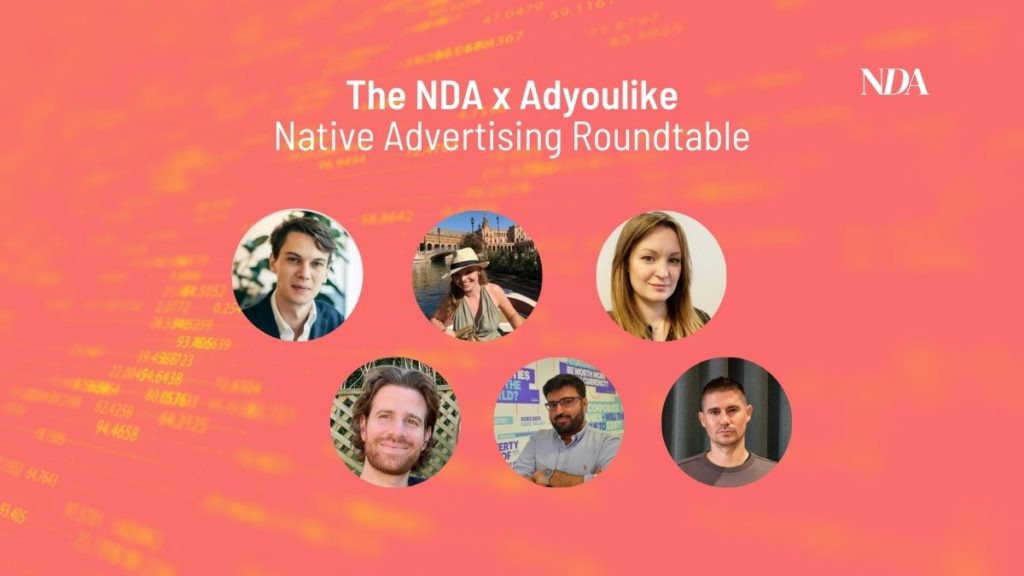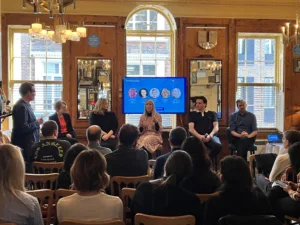Native advertising is attracting the attention of a new generation of brand advertisers. In the search for privacy-compliant contextual ways to target customers online, native is emerging as a channel capable of delivering both performance and brand equity uplifts – but only if leveraged effectively.
New Digital Age (NDA) in association with Adyoulike, recently hosted a roundtable discussion of industry experts to explore where native advertising is best deployed in the marketing funnel and how the measurement of native campaigns is evolving to meet the contemporary needs of advertisers.
NDA’s managing editor Justin Pearse chaired the session, where he was joined Eloise Purnell, Biddable Associate Director, Performics @Starcom; Amir Malik, Managing Director & Growth Marketing Practice Founder at Accenture; Clare Ritchie, Global Head of Programmatic, MediaCom; Charlie Ashe, Head of Client Data and Strategy, tmwi; Ross Coombes, Programmatic Commercial Director, Mindshare UK; and Kevin Sewell, commercial director at AdYouLike.
Purnell kicked off the conversation around native’s role within a marketing strategy by pointing out the sheer flexibility of the channel. She said: “”We’ve carried out econometric reviews for a number of clients and we’ve seen that the traffic we’re driving from native tends to be really unique, really new customers. By far, the highest percentage of new users that we’re driving to client sites are coming from native ads. Those quality, engaged new users are invaluable to a brand’s growth. As a result, we’re explaining to our clients that native can’t be measured using the same KPIs as, for example, a social campaign with a similar creative message.
“For us, though, native can sit throughout the funnel, depending on your objective. We have brand awareness level activity in our mix, we have education pieces that look to fill a particular knowledge gap for mid-funnel customers, and we’ve recently started doing a lot more ecommerce through native as well. We’re building native into more of our performance marketing campaigns and we’ve seen really good results so far in line with other social channels.”
Ritchie made the point that native could often be considered and utilised by brands earlier than at present. She said: “A lot of the time, as an industry, we build media plans in silo to the actual creative development. Sometimes we manage to get the timing right and to tie everything together, but sometimes we don’t. As with anything that deserves more of a creative consideration, when it comes to native advertising, brands and agencies are probably talking about it a little too late in both their media planning and their marketing strategy. To make the most of native, there are times when we need to bump it slightly further up the funnel.”
Sewell of Adyoulike agreed that taking distribution into account when you produce your marketing message is essential to leverage the best from native advertising. He commented: “Just last week, I had a creative call with an agency of one of our tech partners and it was really nice to have those early conversations around where in the funnel the content they were developing was going to be, what its purpose was, how they planned to engage with the audience and so on. We know with confidence that native can help move customers through the funnel, so native’s role depends on whatever it is that you’re trying to achieve.”
Made to measure?
One common stumbling block for those brands trying to leverage native advertising is how to measure its effectiveness. Historically, said Purnell, the most popular metrics used to track native campaigns have evolved over time, from impressions, to viewability and engagement, and more recently ‘attention’ (and eye-movement tracking) and ecommerce metrics such as CPA.
Ashe, however, recommends a holistic test-and-learn approach to getting the best insights out of native. He said: “On the whole, clients want to talk about their business objectives and it’s very rare that any single channel is going to provide the whole solution for them. A lot of agencies translate those objectives through to a media strategy and KPIs for the different channels being used, then report back to the client on those numbers for each channel. I think that can lead to the wrong sort of communication between the client and the agency as it focuses on isolated metrics rather than what they are trying to achieve together.
“In terms of native, I think clients get excited by a channel based on the level of insight that’s driven back to them. The earlier that you use individual channels like native for testing – for example, testing content against certain audiences, or against different publications – it becomes easier to see how native interacts with and amplifies other channels.”
Coombes explained that while the majority of modern marketers are broadly aware of what native is in theory, a smaller number are familiar with the nuances of native in practice. He said: “The way that native is run and managed is different from a standard display or video campaign. Brands need to give native some individual attention and thinking-time – it needs its own internal processes and timescales to get the most out of it. In some ways, native is more similar to traditional TV campaigns where you have a creative deadline that’s locked in well ahead of the actual broadcast.”
The experts agreed, however, that native can also be a lot more flexibly deployed than TV and, what’s more, can act as ‘connective tissue’ between the various strands of an omnichannel campaign.
Malik closed out the discussion by suggesting that, when it comes to native proving its value to marketers, the best might still be yet to come. He said: “Traditional banner ads are, for a large part, dead as a format. They’re just not effective anymore. Native advertising, by contrast, provides a colossal business opportunity for brands to get the attention of target audiences in a way that doesn’t need to be deeply personalised and doesn’t interfere with the user experience. Consumers respond well to native and are less likely to become immune to it.
“I think that when we finally lose third-party cookie, native will move on to the radar of many more CMOs. It’ll be interesting to see what role native begins to playing in terms of engagement and how the metrics around native continue to evolve to capture its impact on brand equity and performance.”
The first part of this roundtable writeup can be read here.









